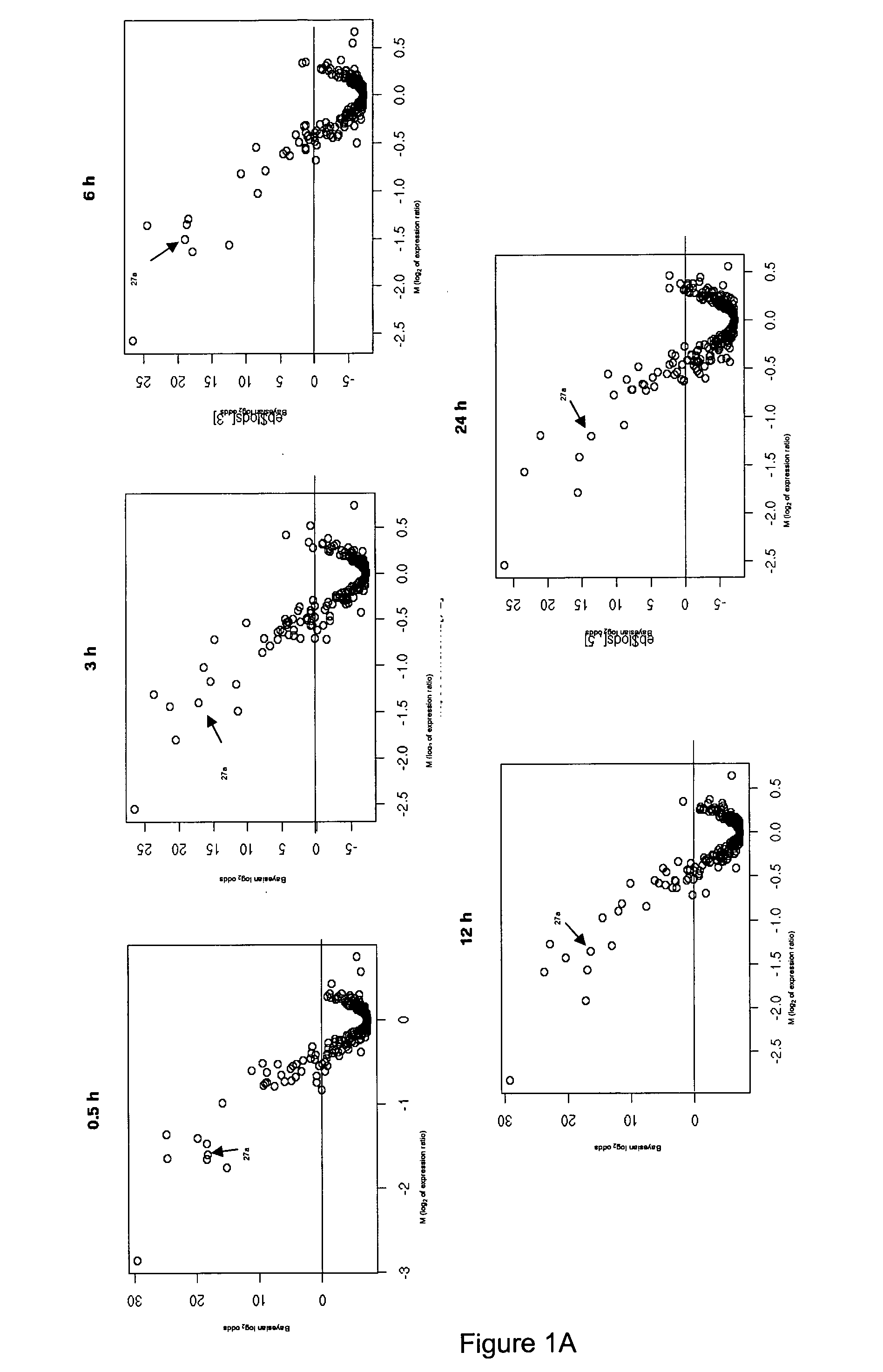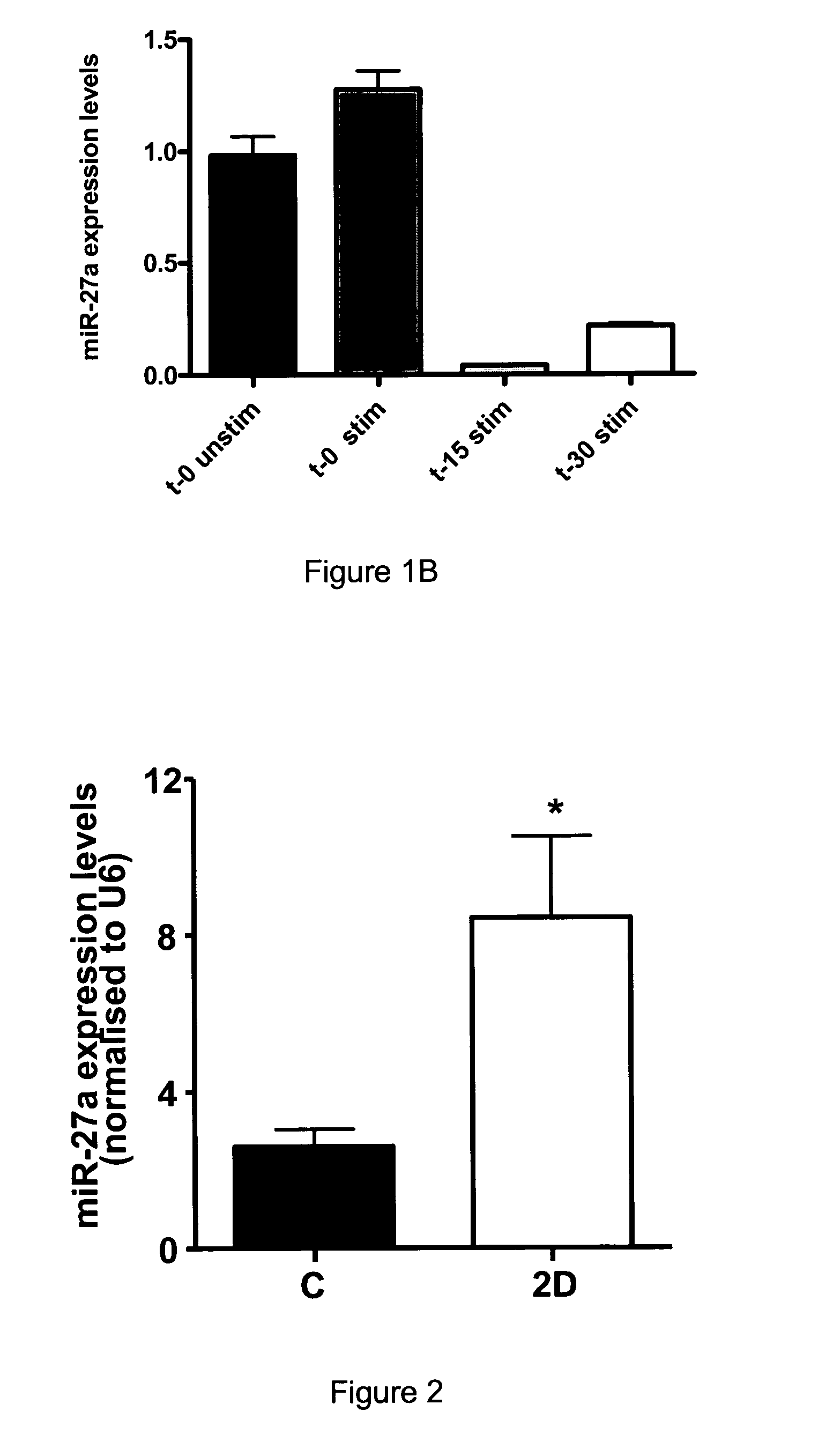Therapeutic and Diagnostic Molecules
a technology of diagnostic molecules and therapeutics, applied in the field of microrna species (mirnas), can solve the problems of limited success in the development of effective anti-angiogenic agents
- Summary
- Abstract
- Description
- Claims
- Application Information
AI Technical Summary
Benefits of technology
Problems solved by technology
Method used
Image
Examples
example 1
Regulation of miRNAs During Angiogenesis
[0096]Microarray analysis was conducted to determine patterns of expression of miRNA under angiogenic conditions in human umbilical vein endothelial cells (HUVECS). HUVECs were isolated by collagenase treatment as described in Gamble et al., 1993 (J Cell Biol 121:931-943). The cells were cultured in gelatin (Sigma) coated 25 cm2 flasks in HUVEC medium (M199 with Earles Salts, 20 mM HEPES, 20% foetal calf serum (FCS; Cytosystems), sodium bicarbonate, 2 mM glutamine, nonessential amino acids, sodium pyruvate, fungizone, penicillin and streptomycin). Cells were grown at 37° C., 5% CO2. HUVEC formed a confluent monolayer within two to four days and were then harvested by trypsin-EDTA treatment and transferred into a gelatin coated 75 cm2 flask. Endothelial growth supplement (50 μg / ml, ECGS, Collaborative Research) and heparin (50 μg / ml, Sigma) were added. Cells were passaged (1:2 split) every three to four days and were used between passage two an...
example 2
Overexpression of hsa_miR—27a Inhibits Vessel Formation
[0101]The effect of hsa_miR—27a expression on vessel formation was investigated in both in vitro and in vivo models of angiogenesis.
General Methods
[0102]Transfection with Pre-miR™ miRNA Precursor Molecules.
[0103]HUVEC were seeded at 6×105 cells per 25 cm2 flask and 24 h later were transfected with synthetic microRNAs (Pre-miR™ miRNA Precursor Molecules, Ambion) at a final concentration of 15 nM using HiPerFect transfection reagent (Qiagen). Total RNA and protein were collected at either 24 h or 48 h post transfection. HEK293 cells were seeded at 5×104 cells in a 24-well plate and were transfected 24 h later with 50 ng of plasmid in addition to synthetic microRNA molecules at a final concentration of 15 nM. Cell lysates were made 24 h post transfection.
RNA Extraction and Real-Time PCR.
[0104]Total RNA was isolated from HUVEC by Trizol extraction (Invitrogen) according to the manufacturer's instructions. Isolated RNA was subsequent...
example 3
hsa_miR—27a Expression in Human Disease
[0111]The level of expression of hsa_miR—27a was determined in endothelial cells from human patients with hepatocellular carcinoma. Archival material of paraffin fixed liver samples from patients with hepatocellular carcinoma were obtained through the Liver Department of Royal Prince Alfred Hospital. Paraffin embedded liver sections were also obtained from three patients with cirrhosis. The fibrotic area surrounding the regenerative nodules is known to be a setting where neo-vessels are forming and this area in normal liver is free from such neo-vessels. Blood vessels were detected using PECAM expression. Excision of endothelial cells from the venule and neo-angiogenic vessels were achieved using the Arcturus PixCell Ile instrument. Extraction protocol was as recommended by the manufacturer. Laser diameter was set to 7.5 μM and laser pulse set at 0.2 seconds. Endothelial cells were transferred onto CapSure Macro LCM Caps which enables the preci...
PUM
| Property | Measurement | Unit |
|---|---|---|
| time period | aaaaa | aaaaa |
| emission wavelength | aaaaa | aaaaa |
| excitation wavelength | aaaaa | aaaaa |
Abstract
Description
Claims
Application Information
 Login to View More
Login to View More - R&D
- Intellectual Property
- Life Sciences
- Materials
- Tech Scout
- Unparalleled Data Quality
- Higher Quality Content
- 60% Fewer Hallucinations
Browse by: Latest US Patents, China's latest patents, Technical Efficacy Thesaurus, Application Domain, Technology Topic, Popular Technical Reports.
© 2025 PatSnap. All rights reserved.Legal|Privacy policy|Modern Slavery Act Transparency Statement|Sitemap|About US| Contact US: help@patsnap.com



